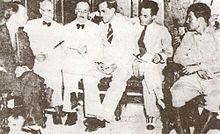Pentarchy of 1933
| Pentarchy of 1933 | |
|---|---|

José M. Irisari, Porfirio Franca, Guillermo Portela, Ramon Grau, and Sergio Carbó “The Pentarchy” with Fulgencio Batista taken in 1933
|
|
| Executive Commission of the Provisional Government of Cuba | |
|
In office 5 September 1933 – 10 September 1933 |
|
| Preceded by | Carlos Manuel de Céspedes y Quesada (as Provisional President) |
| Succeeded by | Ramon Grau (as President) |
| Personal details | |
| Nationality |
|
Pentarchy of 1933, formally known as the Executive Commission of the Provisional Government of Cuba, was a coalition that ruled Cuba from September 5 to September 10, 1933 after Gerardo Machado was deposed on August 12, 1933. Prior to the Pentarchy, General Alberto Herrera (August 12–13, 1933) and Carlos Manuel de Céspedes y Quesada (August 13 - September 5, 1933) served as President of Cuba.
The members of the Pentarchy were:
The first thing the Pentarchy did was to draft a proclamation which was written by Sergio Carbó and signed by eighteen civilians and one military man, Fulgencio Batista. That proclamation was published in every Cuban newspaper the following day. Carbó later promoted Batista from a sergeant to colonel without notifying the other four. Later they were ousted by the Student Directory and Ramón Grau was named president.
U.S. ambassador to Cuba Sumner Welles noted in a telegram to the Secretary of State that late at night on September 6, 1933, Dr. Horacio Ferrer, Secretary of War in the Carlos Manuel de Céspedes y Quesada Cabinet, called to see him. He advised the ambassador that he was in contact with sergeants in control of the Fortress La Cabaña who advised Ferrer that they were deceived in participating in the mutiny and that they were prepared to make any reparation for their action. Ferrer's plan would be as follows, after taking some preliminary measures, Ferrer, accompanied with 80 loyal officers would proceed on September 8, 1933 to the Fortress La Cabaña with President Cespedes and several other members of his Cabinet and that on early morning September 9, 1933, Ferrer would proclaim the support of the Fortress to the legitimate Government of President Cespedes. Ferrer would then ask the ambassador whether “should this action be taken, and should Cespedes Government make such request the Government of the United States would be willing to land troops from the battleships now due to arrive at Cojimar immediately to the east of Cabaña Fortress, in order to assist the Cespedes Government in maintaining order.”
...
Wikipedia
